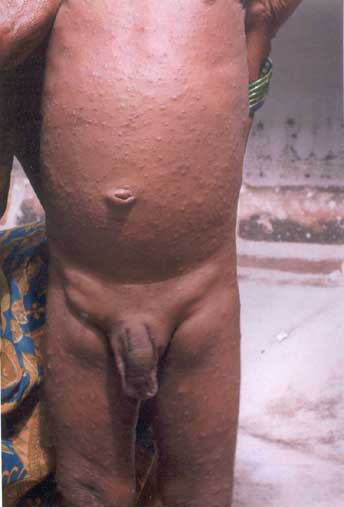A 2-year-old male child
presented with itchy eruption over whole of the body of 6-months
duration. The child was the second sibling in the family and had no
history of blood transfusion. Both his mother and father were suffering
from HIV infection. Besides this, his mother had crusted scabies. On
physical examination, the child was irritable and had prominent
generalized, discrete, soft to firm, non-tender lymphadenopathy (Fig.
1). Cutaneous examination revealed nearly bilateral symmetrical
involvement of extremities and trunk (Fig.1) by discrete, but
extensive erythematous papular and papulovesicular lesions. The shaft of
penis and scrotum were involved by similar lesions. The finger web
spaces showed typical burrows. In addition, pustular lesions were seen
over the palms and soles (Fig. 2). Hair, nails and mucous
membranes were normal. His systemic examination was otherwise normal.
Skin scrapings from his
mother-crusted lesions (over the abdomen) demonstrated a number of live
mites and burrows in the scales with eggs and fecal pellets. A few eggs
and fecal pellets were seen in the scrapping taken from the finger web
spaces of the child. On the basis of above findings, a diagnosis of
exaggerated scabies (with a suspicion of underlying HIV infection) was
made. His serology for syphilis and HIV antibodies showed him to be HIV
seropositive; however, VDRL test was non-reactive. He was managed with
5% sulphur ointment.
Scabies is a common cutaneous
manifestation seen in HIV infected patients. The defining clinical
features of scabies in the HIV positive patient are often determined by
the degree of immunosuppression. The typical presentation with scabies
occurs in HIV infected patients with relatively normal immune function.
However, as patients become progressively more immuno-suppressed, the
more contagious and fulminant forms of scabies become apparent. These
severe and unusual forms of scabies can be divided into two overlapping
and broad categories; exaggerated (also known as atypical or papular)
scabies and

Fig. 1. Abdomen and
lower extremities showing exaggerated scabies rash with inguinal
lymphadenopathy.
crusted (also known as
Norwegian or hyperkeratotic) scabies. The exaggerated forms are
characterized by generalized papules, each of which is topped by a
scabietic burrow, which may be scaly. Patients complain of severe
pruritus with this form. The crusted forms are characterized by thick,
friable, white grey plaques, which may also be diffuse, but are commonly
localized to individual body regions including the scalp, face, back,
buttocks, nails and feet. The plaques are often associated with
fissuring that may be mild to severe. Furthermore, as a patientís
lesions become crusted they tend to become less pruritic. The
distinction between papular and crusted scabies is not mutually
exclusive and some reports document patients with lesions
characteristics of both forms. Rarely, bullous scabies may also be
encountered. Scrapings from skin lesions and skin biopsies will be
teeming with mites (can increase to millions).

Fig. 2. Palms
demonstrating pustular lesions
In infants, topical
therapy with sulphur ointment and crotamiton is preferred. Permethrin 5%
cream is the safest as well as the most effective medication for
scabies. Total body application and multiple applications may be
required. Keratolytic agents may be needed in crusted scabies. Crusted
scabies is extremely difficult to eradicate and may require repeated
applications of scabicides for weeks to months. Ivermectin, an
antihelmintic agent can be given in a single oral dose (200 microgram
per kg body weight). Though effective, its safety profile needs to be
established.
Devinder Mohan Thappa,
Kaliaperumal Karthikeyan,
Department of Dermatology
and STD,
Jawaharlal Institute of
Postgraduate Medical Education and Research,
Pondicherry 605 006, India.
E-mail:
[email protected]
